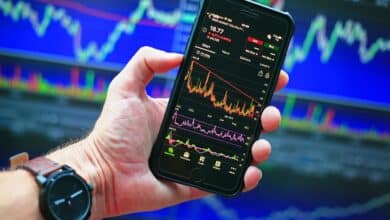What Is Grid Trading And How Does It Work?

Introduction
As the investors move forward in their trading journey, they are gaining more insights into the ways of trading apparatus. Trading is such a skill that can be improved by breaking it down into the smallest components and studying each factor in detail. To this end, aspiring investors should learn about Grid Trading concerning one of the building blocks of trading i.e., trade orders.
What is Grid Trading?
Grid Trading is another trading strategy that is created keeping in view the variable and ever-changing market conditions. Historically speaking, investors and analysts have tried their best to come up with a trading strategy that is easy to execute and ensures profits as much as possible. The grid trading system is the outcome of such an attempt as well.
Grid Trading is about setting up multiple price points in advance to define sell or purchase levels during a trading period. It means that the trader is going to nominate a set of price levels where their broker is going to conduct sales or purchases for their position when these price points become parallel to the market value of the asset in question.
How does Grid Trading Work?
Grid Trading is a simple yet effective trading strategy that can maximize the chances of a profit for investors. At the same time, the investors can also mitigate the risks associated with market volatility for their asset class.
Grid Trading is classified as a systematic trading strategy that does not depend heavily on human judgment and takes advantage of the market volatility to generate profits for the investors.
In the modern age, Grid trading is mostly performed by Trading Bots that are provided by online trading platforms, and in some cases, the investors can also create or purchase an independent trading bot from a reliable source.
For example, Mr. X intends to purchase a forex pair for trading. So, he will examine the price trend of the currency and put a buy order at an interval of 15 pits above the baseline purchase price.
Therefore, every time when the market value of the currency in question reaches any one of these 15 pits above thresholds, Mr. X is going to purchase more currencies. In the same vein, Mr. X can also generate a sell order set at ten pips below the set price for the same currency in question. In this manner, Mr. X can generate a range of orders that can ensure high returns and prevent losses.
It is worth mentioning that the action price intervals depend on the observation and analysis of the investor. The investors can also select a range or nominate specific price points for these Grid tradeoffs.
What are Trade Orders?
The definition of Grid Trading has highlighted a basic component of the trading process, namely orders. Investors who are interested in honing their trading skills must learn more about trader orders. Trade orders are not always as straightforward as a contemporary sell or purchase contract.
Trade orders are a contract that defines the terms and conditions of trade purchases and sells. Trade orders can contain information like how much the trader is willing to pay and how many assets, such as stocks or cryptocurrency units, they are willing to sell or purchase.
In the same manner, Trade orders can also entail the details about the total sell price offer for a set number of assets. Furthermore, the trade orders also define the terms of payouts, such as if the trader is going to make all payments at once or issue in installments.
Additionally, trade orders also explain in detail how many units are going to be sold or purchased under such conditions. Investors can also use trade orders to stop or commence sell or purchase of an asset on account of market changes such as a change in price.
Types of Trade Orders
Trade Orders have many types and subdivisions. Depending on different asset classes and different trading platforms, trade orders can take different shapes because they are highly customizable. Therefore, investors should always acquire all the information about every type of Trade order before they jump into the trading arena. However, investors who are just getting started can benefit from learning about the 07 basic types of trade orders as under:
Market Order
Market orders are the most straightforward types of trade orders. It entails the investors entering into the market looking for the best sell or purchase prices. It means that when the investors enter the market with a willingness to accumulate or sell assets, the system is going to allow them to sell or purchase the given asset at the best current market price available.
Since there are no conditions involved in Market Orders, these orders are often executed immediately. Furthermore, the investors using Market orders do not have any control over the price of the asset, but the chances for the fulfillment of this type of order are always exponential.
Time Duration Orders
Sometimes, investors want to make orders based on the ideal timing. In such cases, the investors can take advantage of time duration orders. Here are three main types of time-based orders:
- Good-for-Day orders can remain valid until the current trading session ends.
- Good-till-Day orders can remain open and active for a few days.
- Immediate or Cancel order gets canceled if the order is not carried out immediately and will cancel itself. For this type of order, all the conditions of the order terms should be fulfilled to make sure that it does not cancel out.
Limit Order
A limit order is a scenario where the investors have more control over their trading terms. In this type of order, the investors can define the acceptable prices for buy or sell orders in advance. Therefore, the limit order does not take its cue from the market and waits for the asset price to reach a defined threshold.
Limit orders are considered useful among professional investors who are using leverage positions or conducting bulk trades because even the smallest fraction of changes in the price of the assets can make a big difference in their trade outputs.
Cover Order
A cover order is a type of order where the investors can create a new short or long position with the addition of stop-loss within the same order form. Stop-loss is the defined threshold where the investors wish to dissolve their trading positions.
Stop-Loss Order
As mentioned earlier, Stop-loss order is one of the most popular trading tools used by professional and retail investors alike. Stop-loss is a marked trade level that is a danger zone for an investor.
It means that the traders use stop-loss to prevent expanding their losses and exiting their trade positions. For example, a trader purchases XYZ stock for $100 per unit.
The trader projects that the prices of said stock are going to show an average rise in the next ten years. However, their technical analysis indicates that if the stock price falls below $40 per unit, the profits of the investors are going to vanish despite the compounding effect.
Therefore, the investor is going to put a stop-loss at $40 to prevent sustaining massive losses. Sometimes, investors also use Stop-loss to prevent margin calls. There are two main types of stop-loss orders:
Stop-loss Market Order
Stop-loss market orders are where traders plan to exit their positions when the prices for the asset go against their expectations. For example, if an investor purchased an asset at $10 and the price goes to $9.5, they are going to exit the position.
This type of stop-loss can prevent increasing the losses immediately for the investors in case their trading positions are not going as per their projections or in the opposite direction from their expectations.
The word ‘market’ is added to the term because rather than waiting to increase their losses, the investor opts to automatically exit their trading position at the unfavorable market prices.
Stop-loss Limit Order
A Stop-loss limit order is very similar to other stop-loss orders. However, in this instance, the investors do not plan to exit their positions at market prices but rather define the exit prices. Therefore, the trigger price for exiting in a stop-loss limit order is based on the predetermined set prices by the investors.
Bracket Order
A bracket order or BO is a type of trading order that contains three distinct types of orders packed into one. This order can contain the entry price, target price, and stop-loss at once. It is worth noting that all BOs are strictly limited orders.
For example, if the mean price of an asset is $170. The investor can create a BO where the short or long price is $150, the target is ten points, and the stop-loss is at $110.
After-Market Order
After Market Order (AMO) is a type of trade order that allows investors to carry out tradeoffs outside of trading hours. These types of orders are more productive for the stock or forex traders because the regulated exchange markets sessions are on weekdays and between 9-5 mostly.
Therefore, investors cannot make trades when the markets are closed under normal circumstances, but the price movement continues. However, the duration for the AMOs is not free and open, and these timings need to be specified by brokers. After-market orders are both limit and market kinds.
Types of Grid Orders
Grid orders are not divided into different types. However, with the view of different market conditions, Grid orders can behave in a varying manner. Therefore, here are the types of Grid orders given as under:
For Sideways Markets
Grid orders are typically most beneficial when the markets are moving sideways. When the prices of an asset have been oscillating within a close range, avoiding any major upward or downward, it is said to be in a sideways condition.
Therefore, the investors can select several points on both sides e.g., headwinds and tailwinds, to ascertain sell or purchase points. The frequency of tradeoff points is not more than 5 to ensure a stable entry or exit. The important prerequisite for this point is that the investors need to isolate a reference line based on a price range or trading period first.
For Up Trending Markets
When the investors are using Grid orders for appreciating markets, they can place several points for the accumulation of their positions.
However, for long positions, the investors need to put the sell points near the uptrend markets to avoid losing their progress thus far in the trading process. At the same time, investors always place maximum and minimum tradeoff points to gain full control of the Grid orders.
For Down Trending Markets
For down-trending markets, investors can place shorting positions. Therefore, they have to do the opposite of everything that they do in the case of uptrend markets. This time, the trader will find a range and place the minimum and maximum tradeoff points.
At the same time, they can place the purchase points in reveres on the reference line to purchase as the price falls. To match the purchase points, the investors are going to place a selling point right behind the purchase point to make sure that they don’t lose their progress in the trade.
Advantages of Grid Trading
To further examine the applications of Grid trading, investors should study the following advantages of this trading strategy as under:
Simple Application
The usage of application of Grid Trading is fairly simple to comprehend. It is easier in comparison to the complicated fundamental analytical apparatus such as valuations, growth drivers, and other technical readings.
Furthermore, the investors can rest easy once the price inputs have been established. The Grid Trading system does not require active interference from the investors, and it can keep making trading decisions automatically.
Customization
One of the beauties of the Grid Trading system is that it is highly customizable. Depending on the asset class, the investors can place price inputs with any frequency and magnitude. It is equally compatible with several trading assets such as cryptocurrencies, stocks, commodities, etc.
At the same time, Grid trading can be used in combination with other trading strategies, such as technical indicators. The users can apply the statistics of resistance and support level to find the suitable reference line or discover the correct price input points.
Diversity
Many trading strategies are only suitable for one type of market when the market is increasing in size or in a bearish mode. However, Grid trading is such a phenomenal trading technique that it applies to various types of market environments.
Furthermore, Grid Trading is also ideal for highly volatile markets where the prices can turn at any time and prevent investors from incurring huge losses.
Forex Friendly
Forex trading is the largest trading market in the world. Grid trading was initially used and tested in the Forex Trading market successfully. The effective implementation of Grid Trading in the forex market, faring at $6.6 trillion trading volume per day, proves its efficiency and reliability for traders.
Human Err
Trading is essentially a game of predicting the future. Therefore, even the top investors are unable to make accurate projections about market movements. Strategies like Grid Trading are held in high esteem because they can safeguard investors against the evils of human error in the following ways:
Grid Trading prevents investors from getting swayed by herd mentality and gives them the liberty to create several stop-loss and accumulation points to grant them better control of their portfolios.
Grid trading also dilutes confirmation bias, where the investors do not get swept up into the speculative forces of the market and avoid any biased trading beliefs they have held.
Most investors suffer from losses because they fall victim to recency bias, where they put more emphasis on recent price changes. However, grid trading prevents it.
Another trading bias is anchoring, where the investors believe that they have to wait till a predetermined benchmark price. However, grid trading can remove any irrelevant and irrational investment areas.
Limitations of Grid Trading
Here are some of the negatives of Grid Trading that every investor should keep in mind:
Stop-Losses
Stop-losses are the predefined exit points for a given trading position. The biggest issue with Grid trading is that the market movements are often unpredictable for the investors.
Therefore, if an investor has placed tradeoff points for a sideways market and the market moves in an upward or downward direction instead, the traders can sustain heavy losses, and it can keep increasing the damages as long as the market continues to travel in the opposite or unexpected directions.
Hedging
Hedge Grid Trading is the method where the investors not only define purchase points but also input sell points simultaneously. In this manner, the investors can make sure never to lose money no matter the direction of the markets. However, it can be a tricky process to figure out the correct sell and exit points, which can make or break the profit margins for the investors.
Position Sizes
Position sizing is the method of finding the correct trading range for Grid Trading prices. However, the investor should ensure that every individual tradeoff can affect the overall trading by only a small percentage, keeping in view the rule of not putting all eggs in one basket.
Conclusion
Grid Trading is one of the most used methods of trading and generating profits. It can ensure massive profits for investors who are not familiar with the fundamental and technical indicators.
At the same time, investors also are not affected by the forces like the unpredictable movement of the market and human error. In this manner, investors who are only learning to trade can also generate secure profits in the marketplace.
Tokenhell produces content exposure for over 5,000 crypto companies and you can be one of them too! Contact at info@tokenhell.com if you have any questions. Cryptocurrencies are highly volatile, conduct your own research before making any investment decisions. Some of the posts on this website are guest posts or paid posts that are not written by Tokenhell authors (namely Crypto Cable , Sponsored Articles and Press Release content) and the views expressed in these types of posts do not reflect the views of this website. Tokenhell is not responsible for the content, accuracy, quality, advertising, products or any other content or banners (ad space) posted on the site. Read full terms and conditions / disclaimer.







